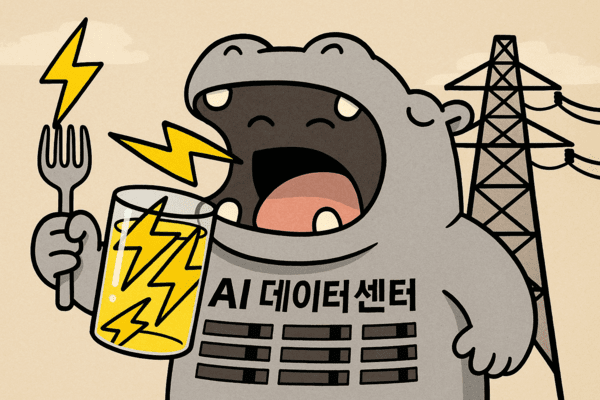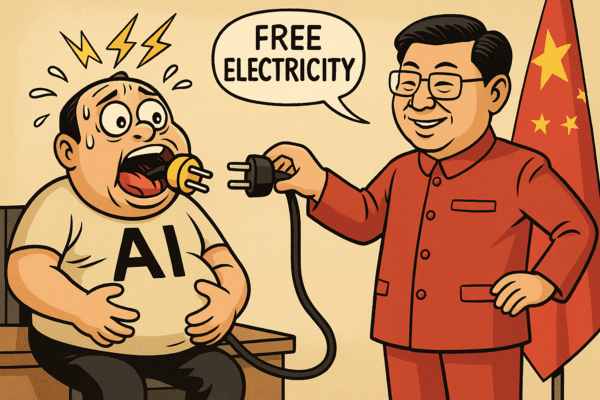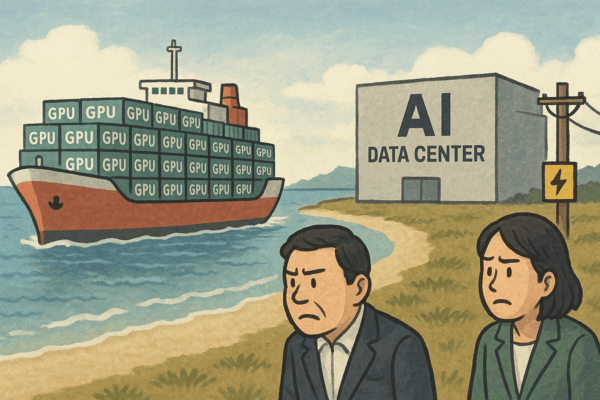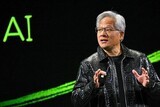“Without electricity, there is no AI”

The brutal reality revealed by the U.S.–China data center race
Behind the fierce AI rivalry between the United States and China lies an invisible battleground: electricity. In the AI age, the true differentiator is no longer algorithms, but how cheaply, stably, and sustainably a nation can supply power.
Yet South Korea remains trapped in the framework of its post-nuclear, eco-transition policy. While it boldly declares ambitions to become an “AI powerhouse,” there is no concrete blueprint for how to secure the power needed to sustain it.
U.S. Data Centers Now Consume as Much Power as Small Cities
Since the global AI boom, data centers in the U.S. have begun consuming as much electricity as entire industrial zones.
According to the U.S. Energy Information Administration (EIA), total annual electricity sales were about 409.7 billion kWh in 2024, projected to reach 419.3 billion kWh in 2025 and 428.3 billion kWh in 2026—with much of this increase driven by AI data centers.
In Memphis, Tennessee, for example, the region surrounding an xAI data center faced such severe power shortages that additional gas turbines had to be rushed in, straining both the local grid and water systems.
The scale is staggering. A single NVIDIA Blackwell GPU consumes 700 watts, and a standard NVL72 rack equipped with 72 GPUs draws over 50 kW. With thousands of such racks operating continuously, training one AI model can consume the electricity of an entire city.

China Turns Power Into a Weapon for AI Growth
China, meanwhile, is weaponizing its energy strategy to boost AI competitiveness.
Local governments across the country are offering electricity discounts of up to 50% for data centers that use domestically produced AI chips.
Regions such as Guizhou, Gansu, and Inner Mongolia—areas with surplus power—are transforming into major AI infrastructure hubs. By subsidizing power, China offsets the inefficiency of its homegrown chips and scales its AI industry through national-level economies of scale. Electricity has become not merely infrastructure but a strategic asset shaping global power dynamics.

Korea’s Reality: GPUs Without Enough Power
South Korea recently secured 260,000 GPUs from NVIDIA to accelerate its AI infrastructure. However, experts estimate that running these chips alone would require the equivalent of one nuclear power plant (1 GW) of additional electricity.
According to the National Assembly Research Service, the power demand from data centers planned through 2029 would total the output of 53 nuclear reactors.
In reality, however, Korea’s energy policy remains paralyzed. The license extension for the Kori-2 nuclear reactor has been repeatedly delayed, and new nuclear projects remain politically deadlocked. The inertia of the country’s “post-nuclear” stance still lingers.
Green Energy Matters, But AI Runs 24/7
AI data centers must operate 24 hours a day without interruption.
Renewables such as solar and wind are vital for sustainability—but their intermittent nature means they cannot guarantee stable supply, especially at night or during windless periods. Thus, base-load power becomes the cornerstone of any serious AI infrastructure plan.
This is not simply about building more plants. The AI era demands a redesign of the entire power structure.
According to Bloomberg, the U.S. Department of Energy (DOE) is already confronting this head-on. In 2024, it announced plans to combine next-generation small modular reactors (SMRs) and hydrogen turbine power to meet AI data center energy demand.
To Be an AI Powerhouse, You Must First Be an Energy Powerhouse
For Korea to stay competitive in the global AI race, three urgent actions are required:
Strategic Return to Nuclear Energy:
Restart reactors like Kori-2 where safety permits, and design SMR demonstration projects centered around AI data centers.
National AI Energy Policy Package:
Establish a dedicated data center electricity tariff, priority transmission rights, and a fast-track approval system for AI-related energy infrastructure.
Treat Efficiency as Energy:
Improving PUE (Power Usage Effectiveness) from 1.6 to 1.2 is equivalent to adding a new power plant. Efficiency gains should be recognized as “virtual power generation.”
Without Power Planning, AI Is an Illusion
AI is no longer a battle of algorithms—it’s a battle of physical infrastructure: electricity, cooling, and capital investment.
While China wields power subsidies and the U.S. expands its nuclear and hydrogen grids, Korea risks being left behind if it remains mired in ideological debates over nuclear policy.
What’s needed now is not rhetoric but infrastructure design.
In the AI era, the most crucial asset is not a “genius developer,” but a gigawatt of electricity.
To be an AI powerhouse, Korea must first become an energy powerhouse—because energy strategy is technology strategy.
By Tech Pioneer Columnist ㅣ scienceazac@naver.com
- Google Plans to Build a “Solar-Powered Space Data Center” — Finding an AI Power Solution Beyond Earth
- Jensen Huang: “In the AI race, China will be the ultimate winner”… Criticizes U.S. export ban
- China’s Unitree Unveils 180cm Humanoid Robot “H2,” Shaking Up the Market
- BlackRock and NVIDIA Lead $40 Billion Data Center Takeover, Igniting an ‘AI Infrastructure War’
- China Unveils the World’s First Humanoid Robot That Learns New Skills in Just 10 Minutes
- [Tech Column] Is the AI Boom a Bubble in the Making? Michael Burry Targets GPU Depreciation and a $5 Trillion Bet

![[동학] 카카오톡 친구탭, 결국 12월 롤백… “격자형 피드는 선택 옵션으로”](https://cdn.kmjournal.net/news/thumbnail/custom/20251126/5517_10550_1119_1763853080_120.jpg)


![[테크 칼럼] 제미나이3, GPT-5.1을 넘다…AI는 이제 ‘일을 대신하는 시대’로 간다](https://cdn.kmjournal.net/news/thumbnail/custom/20251126/5457_10454_4847_1763621329_120.jpg)



![[낭만 테크 시대] AI 대항해 시대](https://cdn.kmjournal.net/news/thumbnail/custom/20251126/5603_10714_4334_1764121414_160.jpg)

